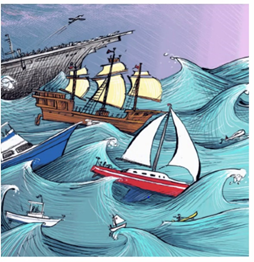WEATHERING THE STORM TOGETHER.
August 7, 2020

One of the advantages of all of us being virtual is that we are getting really good at “warm welcomes” — ways to bring participants into a shared space with a quick exercise that asks them to think quickly and share. I loved this one, used yesterday to kick off the second day of rich discussions with members and friends of CASEL’s Collaborating States Initiative.
The prompt was simple: “What does this picture make you think about as we go into our day?” Great answers, posted in the chat. Here are a few I saw:
- Some are more in danger during the storm
- They will arrive at different times to their destination
- Same storms, different boats
- Not everyone even has a boat- who needs a life raft?
- The size of your boat matters when the waves get rough
Since this was the warmup exercise to a discussion between me and Dr. Aaliyah Samuel from NWEA about rethinking how we partner and engage students, my mind immediately went there. Young people are on the tiny boats with their families. Schools, even wonderfully supportive ones, are the big ship in the background. Well equipped, ultimately better able to weather the storm because of their size and weight, but not very nimble. To reach or rescue a family on a small boat, they would have to send out a boat and crew. But, what if they had a way to communicate with the smaller boats already in the water? And what if all the boats had a way to communicate with each other? What if there was a basic language that all used to communicate the assets they have and or need that could be shared or leveraged to weather the storm? What if this communication system had already been set up and was used not just for emergencies, but as a general way of increasing efficiency and effectiveness?
Want to engage your meeting participants in thinking differently (with more curiosity) about who else is “in the storm”?
- ACT. Try this as a warmup exercise. Use the chat or create a whiteboard.
- REFLECT. Provide a few minutes (full group or small groups) for people to share and compare their reflections, think about how/why this question got them thinking differently.
- APPLY. Get them to work through an analogy that is relevant for the group (e.g., if the school system is the big ship, what are the other types of ships in the water? How do they vary (e.g., size, equipment, purpose, number and characteristics of the passengers, skill of the crew, destination)? When is that variation an asset? When a risk?
- LEARN, IMPROVE, and SUSTAIN.
Listen to Karen Pitman’s presentation with Dr. Aaliyah Samuel, Executive Vice President of Government Affairs & Partnerships at NWEA, here.
The CASEL CSI, which partners with over 40 states to support systemic SEL, provides Insights Reports on state policy and a state resource center.
